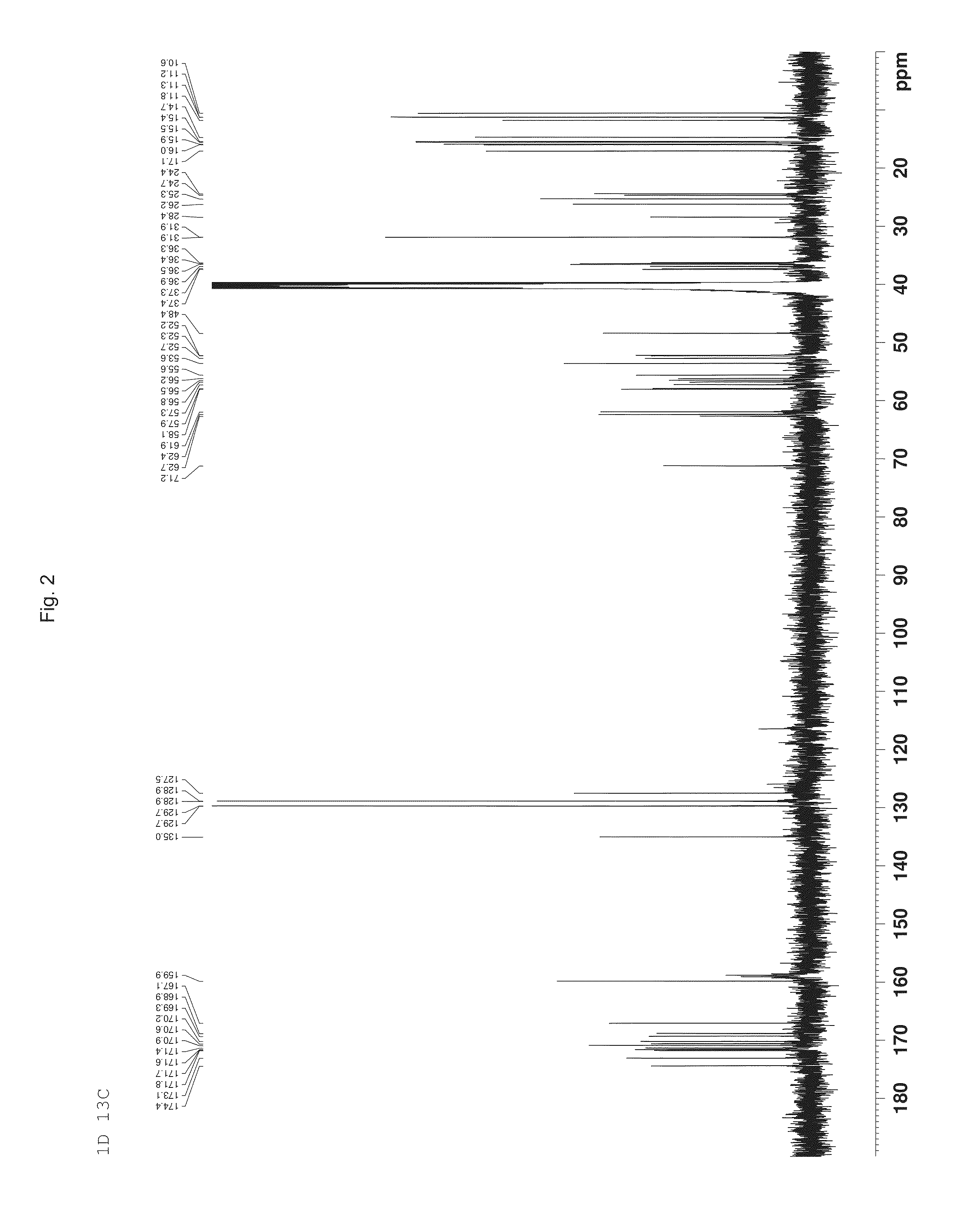Novel depsipeptide and uses thereof
a technology of depsipeptide and peptide, which is applied in the direction of peptide/protein ingredients, antibacterial agents, drug compositions, etc., can solve the problems of antibiotic resistance, drug-resistant microorganisms around the world becoming a serious problem, and the current antimicrobials are not as effectiv
- Summary
- Abstract
- Description
- Claims
- Application Information
AI Technical Summary
Benefits of technology
Problems solved by technology
Method used
Image
Examples
example 1
Preparation of a Compound of Formula (II)
[0137]Bacterial isolate (ISO18629) was grown on 2% bacto agar with 0.125 g / L casein digest, 0.1 g / L potato starch, 1 g / L Casamino acids, and supplemented with 10% R4 (100% R4 being 10 g / liter glucose, 1 g / liter yeast extract, 0.1 g / liter casamino acids, 3 g / liter L-proline, 10 g / liter MgCl2.6H2, 4 g / liter CaCl2 2H2O, 0.2 g / liter K2SO4, 5.6 g / liter TES 0.56%, 1 mL Trace Elements all brought to a total of 1 liter of tap water and adjusted to pH 7.0 with 1.0 M NaOH) and one colony was homogenized and used to inoculate 40 ml of BP seed broth (15 g / liter glucose, 10 g / liter malt extract, 10 g / liter soluble starch, 5 g / liter yeast extract, 10 g / liter casamino acid, 0.05 g / liter calcium carbonate brought to a total of 1 liter with tap water) in a 250 mL flask. After 4 days of fermentation at 28° C. (250 rpm) 12.5 mL of seed culture was used to inoculate 0.5 L of R4 production broth at 2.5% inoculum (v / v). The fermentation was conducted for 7 days at...
example 2
Antibacterial Spectrum
[0151]A compound of Formula (II), prepared in accordance with Example 1, was subjected to a panel of bacterial species. The antibacterial spectrum of the compound is shown in Table 3. Addition of 10% serum had no effect on the minimum inhibitory concentration (MIC). As indicated by the data presented in Table 3, the compound has excellent activity against Gram-positive pathogens, including resistant strains. The compound also has low potency against most Gram-negative bacteria, and good activity against H. influenzae, opening a possibility for treating respiratory tract infections.
TABLE 3Antibacterial activity of a compound of Formula (II)StrainMIC (μg / mL)ATCC 29213 (MSSA)0.16-0.63NCTC 8325 (MSSA)0.08-0.31ATCC 33591 (MRSA)0.16-0.31NRS54 (MRSA)0.078-0.16 NRS108 (MRSA, also synercidR)0.16NRS269 (MRSA, also tigecyclineR)0.16-0.31ATCC 700699 (GISA)0.31ATCC 35984 = NRS101 (mecA positive)0.078-0.16 NRS8 (mecA positive)0.16-0.31NRS34 (mecA positive)0.16NRS9 (mecA posi...
example 3
Cytotoxicity Activity, Hemolytic Activity, DNA Binding, hERG inhibition, Cytochrome P450 inhibitory activity, Genotoxicity, Plasma Stability, Protein Binding
Cytotoxicity Activity
[0154]Cultures of NIH3T3 mouse embryonic fibroblast (ATCC CRL-1658, in Dulbecco's Modified Eagle's medium supplemented with 10% bovine calf serum) and Hep-G2 (ATCC HB-8065™, in Dulbecco's Modified Eagle's medium supplemented with 10% fetal calf serum) were grown for 3 days at 5% CO2 in air, 37° C., humidified. The cultures were trypsinized, counted and seeded into the wells of sterile 96-well flat bottom plate (1500 cells / well / 100 μL for NIH3T3, and 4000 cells / well / 100 μL for Hep-G2). After 24 hours, the media in each well were replaced with 100 μL of fresh media (containing a two-fold serial dilution of a compound of Formula (II) prepared in accordance with Example 1 from 0.8 μg / mL to 100 μg / mL, and a no compound control) that had been incubated for 2 hours at 5% CO2 in air, 37° C., humidified. After anothe...
PUM
| Property | Measurement | Unit |
|---|---|---|
| chemical shifts | aaaaa | aaaaa |
| chemical shifts | aaaaa | aaaaa |
| chemical shifts | aaaaa | aaaaa |
Abstract
Description
Claims
Application Information
 Login to View More
Login to View More - R&D
- Intellectual Property
- Life Sciences
- Materials
- Tech Scout
- Unparalleled Data Quality
- Higher Quality Content
- 60% Fewer Hallucinations
Browse by: Latest US Patents, China's latest patents, Technical Efficacy Thesaurus, Application Domain, Technology Topic, Popular Technical Reports.
© 2025 PatSnap. All rights reserved.Legal|Privacy policy|Modern Slavery Act Transparency Statement|Sitemap|About US| Contact US: help@patsnap.com



